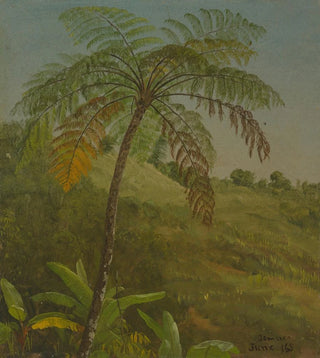Palm Tree Painting Jamaica - Frederic Edwin Church | Art print


View from behind

Frame (optional)
"Palmier Jamaïque" art print by Frederic Edwin Church is an invitation to a sensory journey into the heart of tropical landscapes. In this painting, the artist captures the wild beauty of nature, evoking an atmosphere of serenity and wonder. The vibrant colors and meticulous details transport the viewer to distant shores, where sunlight dances on the lush leaves of the palms. This work, emblematic of the American Romantic movement, stands out for its ability to evoke deep emotions while celebrating the magnificence of the natural world. The art print of "Palmier Jamaïque" by Frederic Edwin Church adds a touch of exoticism and refinement to any space, transforming an ordinary wall into a window onto an idyllic landscape.
Style and uniqueness of the work
Frederic Edwin Church's style is characterized by meticulous attention to detail and bold use of color. In "Palmier Jamaïque," the artist manages to capture light and shadow with impressive mastery. The shades of green in the palms blend with the golden hues of the setting sun, creating a striking contrast that immediately draws the eye. The composition of the piece is carefully balanced, with each element placed to guide the viewer's gaze across the scene. Church, as a master of landscape painting, does not merely depict nature; he interprets it, infusing it with a soul that transcends simple visual representation. This ability to marry realism and personal expression gives "Palmier Jamaïque" a singularity that continues to inspire and delight art enthusiasts.
The artist and his influence
Frederic Edwin Church, a central figure of the Hudson River School, redefined American landscape art through his works. Influenced by his travels in South America and the Caribbean, he incorporated exotic elements into his creations, offering viewers a glimpse into distant worlds. His approach to landscape painting goes beyond mere representation; it is also a reflection on nature and the harmony between man and his environment. Church captured the spirit of his era,

Matte finish

View from behind

Frame (optional)
"Palmier Jamaïque" art print by Frederic Edwin Church is an invitation to a sensory journey into the heart of tropical landscapes. In this painting, the artist captures the wild beauty of nature, evoking an atmosphere of serenity and wonder. The vibrant colors and meticulous details transport the viewer to distant shores, where sunlight dances on the lush leaves of the palms. This work, emblematic of the American Romantic movement, stands out for its ability to evoke deep emotions while celebrating the magnificence of the natural world. The art print of "Palmier Jamaïque" by Frederic Edwin Church adds a touch of exoticism and refinement to any space, transforming an ordinary wall into a window onto an idyllic landscape.
Style and uniqueness of the work
Frederic Edwin Church's style is characterized by meticulous attention to detail and bold use of color. In "Palmier Jamaïque," the artist manages to capture light and shadow with impressive mastery. The shades of green in the palms blend with the golden hues of the setting sun, creating a striking contrast that immediately draws the eye. The composition of the piece is carefully balanced, with each element placed to guide the viewer's gaze across the scene. Church, as a master of landscape painting, does not merely depict nature; he interprets it, infusing it with a soul that transcends simple visual representation. This ability to marry realism and personal expression gives "Palmier Jamaïque" a singularity that continues to inspire and delight art enthusiasts.
The artist and his influence
Frederic Edwin Church, a central figure of the Hudson River School, redefined American landscape art through his works. Influenced by his travels in South America and the Caribbean, he incorporated exotic elements into his creations, offering viewers a glimpse into distant worlds. His approach to landscape painting goes beyond mere representation; it is also a reflection on nature and the harmony between man and his environment. Church captured the spirit of his era,
12,34 €






